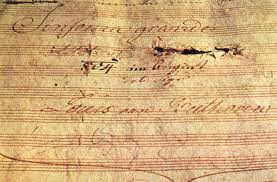Monday’s post featured the first movement of Beethoven’s revolutionary Symphony No. 3 in E-flat major (“Eroica”) Op. 55. This music, which helped plant the seeds of Romanticism, introduced shocking new sounds and an expansive, heroic form. Let’s continue and listen to the other three movements:
[typography font=”Cantarell” size=”28″ size_format=”px”]Marcia funebre. Adagio assai[/typography]
Beethoven’s second movement is a solemn funeral march. Paying attention to the rhythm, consider what aspects of the music suggest a dirge. Why do you think Beethoven chose to put this type of movement in the middle of the “Eroica”? Does the atmosphere remain the same throughout the movement or does the character of the music develop into something new? Can you hear the sounds of the funeral procession fading into the distance at the end?
https://www.youtube.com/watch?v=6l_bPmJifV4
From the opening of the movement you probably heard the basses creating the rhythmic foundation of the funeral march. Beethoven creates a ponderous, weighty feeling by marking the downbeats with the lowest instrument in the orchestra.
At 5:11 the music tip toes almost hesitantly into a new theme in C major from C minor. It quickly crescendos to a sudden heroic statement or proclamation in G major (5:40). Isn’t it amazing how this heroic music can emerge so quickly from the depths of despair and then evaporate (7:32)?
But Beethoven soon has a new surprise in store for us, perhaps the most significant so far. At 8:16, the second violins suddenly launch into the subject of a fugue. A fugue is “a contrapuntal composition in which a short melody or phrase (known as the subject) is introduced by one part and successively taken up by others.” Like the development section of the“Eroica’s” first movement, the music gets increasingly worked up, almost seeming to transcend everything we’ve heard up to this point (10:04). As you were listening the first time through, you may have been shocked by what happens next. At 10:42 we think we are returning to the quiet, predictable opening…but listen to what happens…
It’s no exaggeration to say that this is music which changed the course of music history from Brahms and Wagner through Mahler and beyond. This collection of pitches still speaks to us today as powerfully as it did in 1804. In fact, we often turn to great music like the “Eroica” when we need to try to make sense of tragedy. The Boston Symphony played this movement when President Kennedy’s assassination was announced to concert goers at Symphony Hall in 1963.
[typography font=”Cantarell” size=”28″ size_format=”px”]Scherzo and Finale[/typography]
The word “Scherzo” translates as “joke.” What comes to mind as you listen to the opening of the Scherzo? Maybe it’s breathless anticipation? Do you feel like the lid is about to blow off and the music is set to explode, no longer able to contain its excitement?
The final movement begins at 6:16. Are you surprised by the music which follows the dramatic opening of the movement? It’s only a harmony line without melody…a seemingly insignificant fragment of music. But this is the seed from which the last movement blossoms. What follows is a set of variations which cover exciting and far reaching musical territory. Notice how many different ways this theme can be developed and the contrasting emotions which result. What is each variation saying?
Beethoven’s music conjures up a complex sea of emotions. We often overlook humor in Beethoven, but listen carefully to the passage starting around 15:30. We know that the end of the piece is just around the corner, but listen to the way Beethoven plays with our expectations. I’m not sure if the music beginning at 16:28 is funny or frightening or maybe a mixture of both. How does this music set up the coda? What emotions do you feel as you listen to the end of the piece?
https://www.youtube.com/watch?v=u0eWcb1_uGM
[typography font=”Cantarell” size=”28″ size_format=”px”]Interesting Links[/typography]
Now that you’ve heard the whole piece, you may want to go deeper with some analysis by Leonard Bernstein. Here is Michael Tilson Thomas introducing the piece and then giving a performance with the London Symphony. Also, check out this episode of the San Francisco Symphony’s Keeping Score this link from NPR.
[typography font=”Cantarell” size=”28″ size_format=”px”]The “Eroica” Through Time[/typography]
Over time, interpretations have changed. This fun clip documents the opening chords of the first movement from the earliest recordings up to the present. You’ll hear a variety of tempos as well as tunings. Remarkably it seems fairly easy to guess the style of each performance, based on the opening chords (quite a time saver).
If you want to choose one contrasting performance, I recommend John Eliot Gardiner’s performance with the Orchestre Revolutionnaire et Romantique. This performance attempts to recreate the instruments of Beethoven’s time. You’ll notice that the tempos are significantly faster and the tuning is lower. Also notice the limited use of vibrato in the strings and the valveless trumpets and horns. Brass instruments at that time could play a limited set of pitches controlled by the lip:
https://www.youtube.com/watch?v=c6JtVCYIPYw
[button link=”https://itunes.apple.com/gb/album/symphonies-nos.-3-eroica-4/id150992376″]Find on iTunes[/button] [button link=”http://www.amazon.com/Beethoven-Revolutionary-Symphonies-Nos-Eroica/dp/B0000057EY”]Find on Amazon[/button]
Keep listening to this powerful, revolutionary music. You’ll continue to hear new, exciting things. Share your thoughts in the thread below. If you have a favorite recording of the piece, let us know about it.

